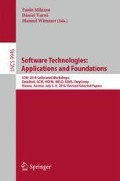Abstract
The Parikh image of a word abstracts from the order of its letters. Parikh’s famous theorem states that the set of Parikh images of a context-free string language forms a semilinear set that can be effectively computed from its grammar. In this paper we study the computation of Parikh images for graph grammars defined by contextual hyperedge replacement (CHR). Our motivation is to generate efficient predictive top-down (PTD) parsers for a subclass of CHR grammars. We illustrate this by describing the subtask that identifies the nodes of the input graph that parsing starts with.
Access this chapter
Tax calculation will be finalised at checkout
Purchases are for personal use only
Notes
- 1.
Due to space restrictions, that paper describes only the HR case.
- 2.
[n] denotes the set \(\{1, \dots , n\}\).
- 3.
Note that a node with just a leaving \(\textit{goto}\) edge can actually not be a starting node although this is indicated by \(\psi ''(S^x_{\textsf {i}})\). The reason for this over-approximation is that rule \([\textsf {g}]_{x}\) can be be applied to \(D(\bullet )\) even if there is no additional node that could be used as a context node, which is actually necessary for applying CHR rule g.
References
Brzozowski, J.A.: Derivatives of regular expressions. J. ACM 11(4), 481–494 (1964)
Costagliola, G., Chang, S.K.: Using linear positional grammars for the LR parsing of 2-D symbolic languages. Grammars 2(1), 1–34 (1999)
Drewes, F., Hoffmann, B.: Contextual hyperedge replacement. Acta Informatica 52(6), 497–524 (2015)
Drewes, F., Hoffmann, B., Minas, M.: Predictive top-down parsing for hyperedge replacement grammars. In: Parisi-Presicce, F., Westfechtel, B. (eds.) ICGT 2015. LNCS, vol. 9151, pp. 19–34. Springer, Heidelberg (2015). doi:10.1007/978-3-319-21145-9_2
Esparza, J., Kiefer, S., Luttenberger, M.: Newton’s method for \(Omega\)-continuous semirings. In: Aceto, L., Damgård, I., Goldberg, L.A., Halldórsson, M.M., Ingólfsdóttir, A., Walukiewicz, I. (eds.) ICALP 2008. LNCS, vol. 5126, pp. 14–26. Springer, Heidelberg (2008). doi:10.1007/978-3-540-70583-3_2
Fischer, P.C., Meyer, A.R., Rosenberg, A.L.: Counter machines and counter languages. Math. Syst. Theor. 2, 265–283 (1968)
Franck, R.: A class of linearly parsable graph grammars. Acta Informatica 10(2), 175–201 (1978)
Huynh, T.-D.: The complexity of semilinear sets. In: Bakker, J., Leeuwen, J. (eds.) ICALP 1980. LNCS, vol. 85, pp. 324–337. Springer, Heidelberg (1980). doi:10.1007/3-540-10003-2_81
Ibarra, O.H., Seki, S.: Characterizations of bounded semilinear languages by one-way and two-way deterministic machines. Int. J. Found. Comput. Sci. 23(6), 1291–1305 (2012)
Kaul, M.: Practical applications of precedence graph grammars. In: Ehrig, H., Nagl, M., Rozenberg, G., Rosenfeld, A. (eds.) Graph Grammars 1986. LNCS, vol. 291, pp. 326–342. Springer, Heidelberg (1987). doi:10.1007/3-540-18771-5_62
Lavado, G.J., Pighizzini, G., Seki, S.: Converting nondeterministic automata and context-free grammars into Parikh equivalent deterministic automata. In: Yen, H.-C., Ibarra, O.H. (eds.) DLT 2012. LNCS, vol. 7410, pp. 284–295. Springer, Heidelberg (2012). doi:10.1007/978-3-642-31653-1_26
Parikh, R.J.: On context-free languages. J. ACM 13(4), 570–581 (1966)
To, A.W.: Model checking infinite-state systems: generic and specific approaches. Ph.D. thesis, School of Informatics, University of Edinburgh, August 2010
Acknowledgements
We thank the anonymous reviewers for the valuable comments.
Author information
Authors and Affiliations
Corresponding author
Editor information
Editors and Affiliations
Rights and permissions
Copyright information
© 2016 Springer International Publishing AG
About this paper
Cite this paper
Drewes, F., Hoffmann, B., Minas, M. (2016). Approximating Parikh Images for Generating Deterministic Graph Parsers. In: Milazzo, P., Varró, D., Wimmer, M. (eds) Software Technologies: Applications and Foundations. STAF 2016. Lecture Notes in Computer Science(), vol 9946. Springer, Cham. https://doi.org/10.1007/978-3-319-50230-4_9
Download citation
DOI: https://doi.org/10.1007/978-3-319-50230-4_9
Published:
Publisher Name: Springer, Cham
Print ISBN: 978-3-319-50229-8
Online ISBN: 978-3-319-50230-4
eBook Packages: Computer ScienceComputer Science (R0)

